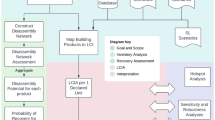Abstract
Constructing a form for concreting a slab of girder bridges presents many difficulties, as mentioned in previous studies on girder bridges. Various construction methods have been developed and applied to improve the form construction. However, each method has problems in terms of cost, quality, construction period, productivity, safety, and transport. To solve these issues, the purlin hanging system form for concreting a slab of girder bridges was developed as an improvement over conventional methods. In order to commercialize the system, it is required to verify that this type of form enhances productivity by providing faster construction completion, reduced cost, and improved quality. Herein, the authors analysed the productivity of the purlin hanging system form for concreting a slab of girder bridges. The purlin hanging system form was found to increase labor productivity by 87%, shorten the construction period by 77%, and provide 59% cost savings compared to conventional forms. A shortcoming of the purlin hanging system form is the high initial investment cost, but this can be resolved through a leasing strategy that enhances reusability. Further study is needed to maximize the usability of the purlin hanging system form.
Similar content being viewed by others
References
Ahsan, R., Rana, S., and Ghani, S. N. (2012). “Cost optimum design of posttensioned I-girder bridge using global optimization algorithm.” Journal of Structural Engineering, Vol. 138, pp. 273–284, DOI: 10.1061/(ASCE)ST.1943-541X.0000458.
Bank, L. C., Malla, A. P., Oliva, M. G., Russell, J. S., Bentur, A. and Shapira, A. (2009). “A model specification for fiber reinforced nonparticipating permanent formwork panels for concrete bridge deck construction.” Construction and Building Materials, Vol. 7, No. 23, pp. 2664–2677, DOI: 10.1016/j.conbuildmat.2009.01.004.
Everett, J. G. and Slocum, A. H. (1993). “Cranium: Device for improving crane productivity and safety.” Journal of Construction Engineering and Management, Vol. 119, No. 1, pp. 23–39, DOI: 10.1061/(ASCE) 0733-9364(1993)119:1(23).
Han, J. (2005). Local analysis of bridge seat considered the critical loading of road and railroad bridge design specifications, MSc Thesis, Hanyang University, Seoul, Korea.
Hanna, A. S., Peterson, P., and Lee, M. (2002). “Benchmarking productivity indicators for electrical/mechanical projects.” Journal of Construction Engineering and Management, Vol. 128, No. 4, pp. 331–337, DOI: 10.1061/(ASCE)0733-9364(2002)128:4(331).
Hyosung LB–DECK (2006). “Bridge slab construction method by LBDECK (PC Panel).” Korea Association of Construction Engineering & Management, Vol. 12, No. 3, pp. 23–28.
Ibbs, W., Nguyen, L. D., and Lee, S. (2007). “Quantified impacts of project change.” Journal of Professional Issues in Engineering Education and Practice, Vol. 133, No. 1, pp. 45–52, DOI: 10.1061/(ASCE) 1052-3928(2007)133:1(45).
Jonasson, S., Dunston, P. S., Ahmed, K., and Hamilton, J. (2002). “Factors in productivity and unit cost for advanced machine guidance.” Journal of Construction Engineering and Management, Vol. 128, No. 5, pp. 367–374, DOI: 10.1061.(ASCE)0733-9364 (2002)128:5(367).
Kaming, P. F., Holt, G. D., Kometa, S. T., and Olomolaiye, P. O. (1998). “Severity diagnosis of productivity Problems-a reliability analysis.” International Journal of Project Management, Vol. 16, No. 2, pp. 107–113, DOI: 10.1016/S0263-7863(97)00036-7.
Kim, I. (2001). Risk management in the construction project, Kimoondang, Seoul, Korea, pp. 120–121.
Kim, G., An, S., Cho, H., Seo, D., and Kang, K. (2005). “Improved productivity using a modified table formwork system for high-rise building in Korea.” Building and Environment, Vol. 40, pp. 1472–1478, DOI: 10.1016/j.buildenv.2004.06.023.
Lim, J., Hong, W., Kim, J., and Kim, S. (2014). “Basic study of the system form for concreting the bridge slab.” Proc. of the 3rd Hong Kong International Conference on Engineering and Applied Science, Hong Kong, China, pp. 79–86.
Lim, J., Kim, S., and Son, K. (2016). “Development of the purlin hanging system form for the girder bridge slab and economic analysis.” Journal of the Korea Institute of Building Construction, Vol. 16, No. 3, pp. 271–278, DOI: 10.5345/JKIBC.2016.16.3.271.
Lim, J., Lee, D., Lim, C., and Kim, S. (2015). “Development of the system form for concreting the girder bridge slab.” Journal of the Regional Association of Architectural Institute of Korea, Vol. 17, No. 6, pp. 195–202.
Moselhi, O., Assem, I., and El-Rayes, K. (2005). “Change order impact on labor productivity.” Journal of Construction Engineering and Management, Vol. 131, No. 3, pp. 354–359, DOI: 10.1061/(ASCE) 0733-9364(2005)131:3(354).
Nasirzadeh, F. and Nojedehi, P. (2013). “Dynamic modeling of labor productivity in construction projects.” International Journal of Project Management, Vol. 31, No. 6, pp. 903–911, DOI: 10.1016/j.ijproman.2012.11.003.
Pan, N. F. (2005). “Assessment of productivity and duration of highway construction activities subject to impact of rain.” Journal of Expert Systems with Application. Vol. 28, No. 2, pp. 313–326, DOI: 10.1016/j.eswa.2004.10.011.
Park, J., Choi, H., Cho, Y., Bang, K., Yun, S., and Paek, J. (2010). “A study on the development of probabilistic duration estimation module using monte carlo simulation.” Journal of the Architectural Institute of Korea Structural & Construction, Vol. 26, No. 5, pp. 101–108.
Shapira, A. and Elbaz, A. (2014). “Tower crane cycle times: Case study of remote-control versus cab-control operation.” Journal of Construction Engineering and Management, Vol. 140, No. 12, pp. 05014010, DOI: 10.1061/(ASCE)CO.1943-7862.0000904.
Sirca, G. F. and Adeli, H. (2005). “Cost optimization of prestressed concrete bridges.” Journal of Structural Engineering, Vol. 131, pp. 380–388, DOI: 10.1061/(ASCE)0733-9445(2005)131:3(380).
Sung, S., Lim, J., Palikhe, S., Han, K., and Kim, S. (2015). “Development of the system form for concrete casting in the girder bridge slab.” Proc. of Sabah International Conference on Engineering & Technology, Computer, Basic & Applied Science (ECBA-2015), Academic Fora, Kota Kinabalu, Sabah Malysia, p. 15.
Author information
Authors and Affiliations
Corresponding author
Rights and permissions
About this article
Cite this article
Kim, S., Lim, J. & Park, J. Productivity Analysis of the Purlin Hanging System Form for Concreting the Slab of Girder Bridges. KSCE J Civ Eng 23, 1–9 (2019). https://doi.org/10.1007/s12205-018-0750-y
Received:
Revised:
Accepted:
Published:
Issue Date:
DOI: https://doi.org/10.1007/s12205-018-0750-y




